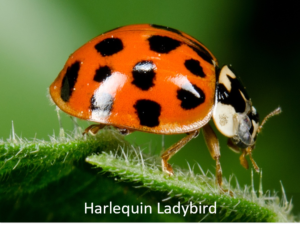Nature Notes – April 2024
by Andy Johnston
Finally, on the afternoon of the 12 March, the wind moved into the west to herald the end of winter. Within days hedges greened up, and magnolias, cherry trees, and daffodils came into full bloom in response to warmer weather. The first brimstone butterflies and queen wasps appeared, and chiffchaffs began to arrive. Lawnmowers were quickly brought out as the grass suddenly grew. Those of you who are gardeners would have seen that bumble bees were active and ladybirds emerging. Some of you have been surprised to find significant numbers of harlequin ladybirds hibernating in your properties.
 They are an invasive species which arrived in southern England in 2004 and have rapidly dispersed throughout the UK. They are harmless, similar in size to our native ladybirds and are orange/red in colour with lots of black spots. Their major drawback is that if squashed, they have a defensive yellow chemical secretion which stains and is very difficult to remove. Those of you with ponds should have plenty of frog spawn by now, and even newts and toads. Elaine tells me that amongst a varied selection of birds on her feeders she has had siskins recently. Swallows, martins, warblers will be here in just a few days!!
They are an invasive species which arrived in southern England in 2004 and have rapidly dispersed throughout the UK. They are harmless, similar in size to our native ladybirds and are orange/red in colour with lots of black spots. Their major drawback is that if squashed, they have a defensive yellow chemical secretion which stains and is very difficult to remove. Those of you with ponds should have plenty of frog spawn by now, and even newts and toads. Elaine tells me that amongst a varied selection of birds on her feeders she has had siskins recently. Swallows, martins, warblers will be here in just a few days!!
